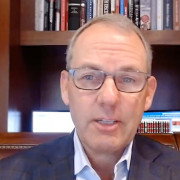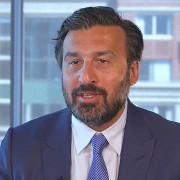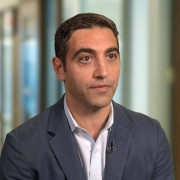Equities
 Direct Indexing: Checking the Box
Direct Indexing: Checking the Box
An in-depth analysis of how screening out companies based on personal values may affect returns on customized index portfolios.
 Tax Management Update – Q1 2024
Tax Management Update – Q1 2024
Although equity markets rose strongly in the first quarter, there were still opportunities for tax loss harvesting in SMA portfolios.
 No Cuts? No Problem.
No Cuts? No Problem.
Portfolio manager Jack Janasiewicz and investment strategist Brian Hess discuss inflation, rates, growth, and positioning in the Natixis model portfolios.
 All About The Rates
All About The Rates
Away-from-zero rates and double-digit volatility have meaningfully enhanced options-based strategies such as those managed by Gateway since 1977.
 60/40 Portfolio Simplicity
60/40 Portfolio Simplicity
See how a 60% stock/40% bond separate account portfolio can be an elegant solution for tax-sensitive investors.
 Pricing ETFs: How Premium/Discount Is Calculated
Pricing ETFs: How Premium/Discount Is Calculated
When considering ETFs, know how premium/discount is calculated – and look at other factors.
 Macro Outlook: Catalysts, Confidence & Cuts
Macro Outlook: Catalysts, Confidence & Cuts
Macro discussion of topics including US growth and the consumer, international markets, inflation, the Federal Reserve, and equity market themes.
 Quality Comparison: Minimum Volatility and High Dividend
Quality Comparison: Minimum Volatility and High Dividend
Historical analysis shows how the equity Quality factor has outperformed Minimum Volatility and High Dividend factors since 1995.
 Investment Portfolio Trends 2023: Looking in the Mirror
Investment Portfolio Trends 2023: Looking in the Mirror
A review of more than 200 investment portfolios highlights the benefits of risk-on allocations as inflation fears ease and markets rebound.
 Bubble Trouble?
Bubble Trouble?
Portfolio manager and strategist Jack Janasiewicz discusses inflation anomalies, February market highs, AI, and comparisons with the dot-com bubble.
 Does the 60/40 portfolio still work?
Does the 60/40 portfolio still work?
Decreased volatility, return potential, and bonds in the 60/40 portfolio are analyzed by Harris Associates’ managers.
 Opportunity Knocks in International Stocks
Opportunity Knocks in International Stocks
While US stocks are getting all the glory, stocks in the MSCI World Index have also been providing attractive returns – and merit investors’ consideration.
 What’s It Take to Be an AI Winner?
What’s It Take to Be an AI Winner?
AI will impact every business, but only a few companies will be winners like Nvidia, says Loomis Sayles’ Aziz Hamzaogullari.
 Avoid Distraction This Election Year
Avoid Distraction This Election Year
Is the stock market more volatile during US presidential election years? A closer look at 2000, 2008 and 2020 offers some perspective.
 Herding Hawks at the Fed
Herding Hawks at the Fed
Portfolio manager and strategist Jack Janasiewicz discusses inflation nuances and the Federal Reserve’s need for “greater confidence” before cutting rates.
 What’s Behind the Value Advantage of International Stocks?
What’s Behind the Value Advantage of International Stocks?
International stocks may have a value advantage despite higher earnings growth in the US, explains Harris Associates’ David Herro.
 Can You Bank on US Financial Stocks for Value?
Can You Bank on US Financial Stocks for Value?
Value investing expert Bill Nygren, CIO-US, Harris Associates, breaks down why US bank stocks look attractive today.
 Quality Matters When Investing
Quality Matters When Investing
Learn how Gateway Investment Advisers uses a disciplined, proprietary approach to build its high-quality stock portfolios for the GQI ETF.
 Economic and Financial Outlook 2024
Economic and Financial Outlook 2024
When will central banks begin to cut rates in 2024? Will liquidity conditions improve or worsen? Should investors look to take on more risk now, or wait until after decisive elections have played out across several key economies?
 Five Institutional Trends Dominated in 2H 2023
Five Institutional Trends Dominated in 2H 2023
How E&Fs led in performance, why private debt interest soared, and other institutional portfolio trends are detailed.
 Sustainable Investing: Transformational trends to watch
Sustainable Investing: Transformational trends to watch
Compelling AI applications, renewable energy recovery, and pharma developments are considered for 2024 by Jens Peers.
 Tax Management Update – 4Q 2023
Tax Management Update – 4Q 2023
Equity markets rose significantly in 2023, but periods of volatility still provided investors with opportunities for tax loss harvesting.
 What Really Matters in 2024
What Really Matters in 2024
Portfolio manager and strategist Jack Janasiewicz explains why growth, labor trends and risk appetite are what matters most to the markets this year.
 Managing Equity Market Volatility in 2024
Managing Equity Market Volatility in 2024
Catalysts for market volatility and ways to help manage it in portfolios are covered by an options expert at Gateway.
 Growth Is Where You Find It: A Look at 2024 Earnings Growth
Growth Is Where You Find It: A Look at 2024 Earnings Growth
Portfolio consultant identifies the sectors and industries most likely to experience earnings growth in 2024. Spoiler alert: US technology still looks good.
 Going Where the Value Is Greater: International Equities
Going Where the Value Is Greater: International Equities
Catalysts for value investing are explored by David Herro, CIO-International Equities at Harris Associates/Oakmark Funds.
 Could Small Cap Stocks Be a Sweet Spot in 2024?
Could Small Cap Stocks Be a Sweet Spot in 2024?
Why the small cap stock universe is an appealing place for Vaughan Nelson’s Chris Wallis to be investing in is explored.
 2024 Investment Idea: Quality/Growth
2024 Investment Idea: Quality/Growth
Using our proprietary Cyclicality vs. Inflation framework to align portfolio positioning with our economic outlook – lean in on Quality and Growth.
 Bright Spot: Emerging Market Small Cap Stocks
Bright Spot: Emerging Market Small Cap Stocks
Small emerging market companies have outperformed their large EM counterparts – and the S&P 500® – over the past year.
 Macro Outlook: Turn the Page
Macro Outlook: Turn the Page
Portfolio strategists offer their take on the Treasury market, interest rates, labor markets, consumption trends and attractive market sectors.
 Growth Trends with a Long Runway
Growth Trends with a Long Runway
Secular growth trends, AI disruptions, and investing during tense geopolitical times are explained by Aziz Hamzaogullari.
 Portfolio Allocation Trends – Q3 2023
Portfolio Allocation Trends – Q3 2023
A review of nearly 300 advisor portfolios shows that taking equity risk and staying short on fixed income duration drove top year-to-date portfolio returns.
 Value Gap in US Equities Is Widening Again
Value Gap in US Equities Is Widening Again
A number of low price-to-earnings stocks are making it an attractive environment for US stock pickers, explains Bill Nygren, CIO-US at Harris Associates.
 Trading Time for Value
Trading Time for Value
How pursuing certain undervalued companies and incorporating factor analysis makes a difference is explained by Vaughan Nelson portfolio managers.
 Triple Discount in International Equities
Triple Discount in International Equities
Significant value in international equity markets and why higher for longer interest rates should benefit European financials is explained by David Herro.
 Tax Management Update – Q3 2023
Tax Management Update – Q3 2023
Although the S&P 500® is up over 13% year to date, the recent pullback has provided tax loss harvesting opportunities for direct indexing investors.
 Cruel September
Cruel September
Portfolio Manager Jack Janasiewicz examines seasonality patterns and the rise in bond yields, oil, and the dollar that weighed on risk assets in September.
 Long Time Horizons Matter for Growth Equity Investing
Long Time Horizons Matter for Growth Equity Investing
Head of Loomis Sayles’ Growth Equity Strategies explains why staying focused on a company’s long-term outlook is essential during market volatility.
 Equity Strategy Chooses Companies Investing for the Future
Equity Strategy Chooses Companies Investing for the Future
Portfolio manager Jens Peers discusses opportunities and positioning in Mirova’s global equity portfolios.
 Bullwhips and the Extrapolation Effect
Bullwhips and the Extrapolation Effect
Portfolio Manager Jack Janasiewicz explains why extrapolating current market trends into the future based on the bullwhip effect may be misguided.
 What’s Next for Europe’s Natural Gas Dilemma and Economy?
What’s Next for Europe’s Natural Gas Dilemma and Economy?
Europe’s avoidance of an energy crisis in 2022, natural gas supply/demand, attractive valuations, and the investment opportunity in the region are analyzed.
 Value Investing Insight with Oakmark Fund Portfolio Managers
Value Investing Insight with Oakmark Fund Portfolio Managers
Oakmark’s distinct approach to value investing and how it ignores short-term noise to deliver long-term results is explained.
 Value Investing in an Evolving World
Value Investing in an Evolving World
Wide price differentials in US equity markets today and lack of diversification in index funds favor value investors like Oakmark, explains Bill Nygren.
 Portfolio Construction: Growth & Cyclical Stocks
Portfolio Construction: Growth & Cyclical Stocks
Portfolio consultants explain how they align equity investments with their current economic outlook using a growth/cyclical barbell strategy.
 A Concentrated Portfolio May Mean Enhanced Returns
A Concentrated Portfolio May Mean Enhanced Returns
High conviction, deep analysis, and concentrated portfolio construction could mean better returns with actively managed ETFs.
 Moderate Model Portfolio Trends Analysis – Midyear 2023
Moderate Model Portfolio Trends Analysis – Midyear 2023
The best performing investment portfolios in the first half of 2023 had the highest exposure to growth stocks and longer-duration bonds.
 Time to Cash into Stocks?
Time to Cash into Stocks?
If you’re keeping your investment money in cash, you’re likely missing out. See three reasons why it may be time to get back into the stock market.
 Five Institutional Investment Trends – Midyear 2023
Five Institutional Investment Trends – Midyear 2023
Recovering institutional investor returns, soaring AI company valuations, and reshuffling real estate sectors due to WFH impact are observed at midyear.
 Mid-Cap Stocks – A Sweet Spot for Investors
Mid-Cap Stocks – A Sweet Spot for Investors
Want companies with fast-growing earnings, agility, sales growth, and access to capital in your stock portfolio? Don’t forget mid-caps.
 Outlook & Opportunities: Global Equities
Outlook & Opportunities: Global Equities
Diverse views on growth trends beyond AI, a recession, China, and where the value may be across global markets are offered by our equity managers.
 Three Reasons to Stay Invested in Volatile Times
Three Reasons to Stay Invested in Volatile Times
Why panic selling during unsettling times may be one of the worst things long-term investors could do is analyzed over three decades.
 Listen to Our Experts Explain the Framework
Listen to Our Experts Explain the Framework
Analysis that combines inflation and growth cycle trends may provide a more nuanced way to understand stock market drivers.
 5 Trends in Model Investment Portfolios – Year-End 2022
5 Trends in Model Investment Portfolios – Year-End 2022
See which trends influenced financial advisors’ asset allocation decisions in their moderate model portfolios in the second half of 2022.
 Observations on Five Institutional Investing Trends
Observations on Five Institutional Investing Trends
Foundations and public pensions lost ground in a challenging investment environment. As we enter 2023, indicators suggest elevated return potential.
 Is the Market Looking Past Lowered Earnings Estimates?
Is the Market Looking Past Lowered Earnings Estimates?
While they aren’t yet reflected in the broad Index, S&P 500® earnings expectations have been revised much lower since mid-year.
 Why Active ETFs Matter During Volatile Times
Why Active ETFs Matter During Volatile Times
NYSE’s ETF Leaders series profiles Vaughan Nelson’s Dan Hughes on how a truly active approach aims to help clients navigate today’s challenging markets.
 From the Consultants’ Desk: Investment Portfolio Construction Trends at Midyear
From the Consultants’ Desk: Investment Portfolio Construction Trends at Midyear
US equity exceptionalism sentiment, value, shorter durations, and unicorns are among the asset allocation trends explored.
 5 Midyear Trends in Model Investment Portfolios – Summer 2022
5 Midyear Trends in Model Investment Portfolios – Summer 2022
As correlations and inflation spiked in the first half of 2022, the best performing investment portfolios held inflation-protection assets, alternatives – and cash.
 Institutional Investing Trends Observed at Midyear 2022
Institutional Investing Trends Observed at Midyear 2022
Amid the failed diversification of disappointing returns from both stocks and bonds, there are some bright spots in institutional investing trends.
 Bottoms Up: Finding Sustainable Growth in a Global Value Chain
Bottoms Up: Finding Sustainable Growth in a Global Value Chain
Through a pint of beer, take a look at how Loomis Sayles’ Growth Equity Strategies Team analyzes the beverage industry’s global value chain.
 Using Option Strategies to Help Manage Portfolio Volatility
Using Option Strategies to Help Manage Portfolio Volatility
Learn how option strategies can help manage the volatility of equities and create a smoother ride.
 Inflation Protection: An Equity-Centric View
Inflation Protection: An Equity-Centric View
Historical analysis highlights which equity sectors and strategies fare best when inflation heats up.



